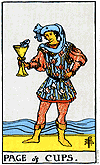
Welcome to my Community Blog for tarot enthusiasts.
Anyone with an interest in tarot, be they student, artist, collector, writer, teacher or reader, is welcome to
to include here.
Answers to your Questions about Tarot: Moving from a Marseille Deck to a Waite Deck
Here’s another installment in my Answers to your Questions about Tarot. This question comes from Matteo. He writes:
Dear Christiana,
I'm Matteo, from Italy, and I'm 23. I'm a big fan of your videos and I loved your Tarot Tour Guide book. I have two questions for you, and I hope you can help me. The first one is quite simple: could you please tell me what is the name of the deck you used in your book cover?
The second question is: I'm a Marseille reader, but I would like to start using a Waite deck as well. The problem is that I'm so used to non-illustrated pip cards that, when I'm using my RWS cards I end up feeling constrained by the images in the minor arcana. Do you have any useful tips?
Thank you very much!
Best wishes
Matteo
Thanks, Matteo. You really made my day!
First, the cards used on my book covers are from Hallmark Tarot by Darla Hallmark. You’re right, that was the easy question.
Your second question was much more challenging! Here are some of my thoughts about moving from a Marseille deck to a Waite deck. In some ways these thoughts could apply to moving from any one tarot tradition into another.
First I think you need to reflect on how the cards speak to you. Do you have memorized interpretations? Do you use associations like numerology, astrology or kabbalah? Do you look at the image and let the image guide you?
I am betting that you do use the images quite a bit, based on your question. I am thinking, too, that non-illustrated pips allow for more scrying, while illustrated pips have us looking at what the person in the picture is actually doing.
I think it is really good to push out of your comfort zone and work into a new tarot tradition. Here are four things that may help.
- Use your regular interpretations and associations, regardless of what deck you are using.
- Learn your cards so well that you can divine simply by knowing the name of the card, rather than looking at the image.
- If you study many decks, remember how the cards are depicted. Whatever deck you are working with, draw on all the images you know for a card when that card comes up in a reading.
- When you look at the image, whether Major or Minor Arcana, don’t focus on what the people in the picture are doing. Let your intuition guide your eyes to small aspects of the picture. Make psychic connections about the things you see in those individual aspects of the picture. That way you are scrying into the picture rather than worrying about what the person in the picture is doing.
I hope that helps!
Thanks again, Matteo! Enjoy the video.
Please email me if you have a question about tarot!
Christiana Gaudet Answers a Question about Reading with Different Decks
Video of Christiana Gaudet Answers a Question about Reading with Different Decks
The Page of Cups
In the new Dreaming Way Tarot, the Page of Cups has a teapot tied to her head.
Really, this is probably no sillier than the RWS Page of Cups with a fish in his cup, but something about it rubbed me the wrong way.
Rome Choi, the designer of Dreaming Way Tarot, explained to me that the teapot represented the emotional limitations of the Page of Cups; in essence, her emotional immaturity.
That's fair. Pages are young, and by that standard they are immature. From this perspective, the element of their suit tells us the area in which the Pages are immature.
Tarot is wonderful in that we all have our own perspective of the cards, and none of us is wrong.
I do not associate immaturity with the tarot Pages, although I understand they can represent youth, and youthful ways of doing things. I do not see weakness in the Pages in connection to their respective elements; I see those elements as their strengths. The Page of Wands is creative. The Page of Swords is smart. The Page of Pentacles has a lemonade stand.
For me, the young Pages possess the honestly and open-heartedness we associate with children. Very often, children are more genuine and authentic than adults. Pages are communicators. Pages are students.
So for me, the Page of Cups is one who can communicate and learn about love with an open heart. I often literally interpret the Page of Cups as "a message of love."
When a child loves, a child loves unconditionally. Many of us spend our adult lives trying to recapture that level of trust.
I embrace the Page of Cups as a communicator of love with no hidden agenda.
How do you see the Page of Cups?



